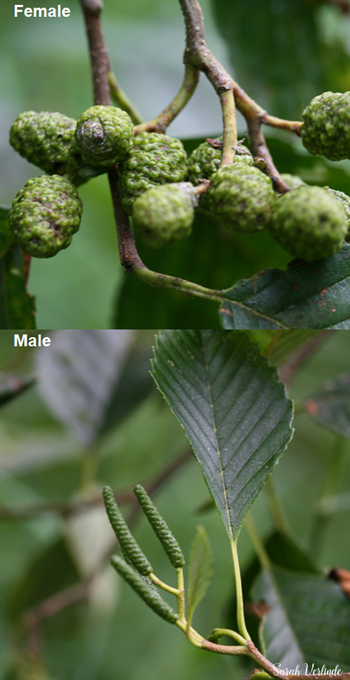Red Alder
Red Alder – Alnus rubra
At a Glance:

- Family: Betulaceae
- Plant Type: deciduous trees
- Distribution: Widely distributed tree in western North America, Alaska to California, as far east as Montana.
- Habitat: Moist areas at low elevations
- Height: 25m
- Flowers: Drooping, slender male catkins in green to brown. Female catkins look cone-shaped and range from green to brown.
- Flowering Season: March – April
- Leaves: ovate shaped with a serrate margin. The leaves are waxy/leathery dark green on top, with a paler green underside.
- Generation: Perennial
- Bark: thin, smooth and mottled gray, often covered in white round patches of lichen.
- Notable feature: The leaf margin in revolute, turning under at the edge, distinguishing it from all other alders. The wood, when bruised, turns a rusty red color, which is how it gets it name.
Restoration and Conservation
Red alder is quick growing and can often be found in sites disturbed by logging or fire. The roots of Red alder contain nitrogen-fixing nodules that can increase the nitrogen in the soil where it is planted. This makes it a very useful conservation tool by increasing the amount of nitrogen available in forest ecosystems or degraded areas.
Ethnobotany
Red alder wood is often used to smoke salmon. Its bark has been used to create red or orange dye due to the inner bark’s red coloring. Red alder bark has been used to make tonics to help with respiratory issues as well as being used as a disinfectant for wounds.
References and Resources
- Native Plants PNW: http://nativeplantspnw.com/red-alder-alnus-rubra
- USDA: https://www.fs.usda.gov/treesearch/pubs/24517
- WTU Image Herbarium: http://biology.burke.washington.edu/herbarium/imagecollection/taxon.php?Taxon=Alnus%20rubra
This article was written by Jessica Rouske and Sarah Verlinde. For questions regarding the UWB/CC Plant Tour, contact Sarah at severlin@uw.edu.
